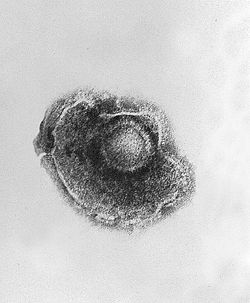Varicella zoster virus: Difference between revisions
imported>Svetlana Musheyev |
imported>Svetlana Musheyev m (→References) |
||
| Line 67: | Line 67: | ||
3.[http://search.ebscohost.com/login.aspx?direct=true&db=cmedm&AN=16763386&site=ehost-live Tony S. Ma Tracie C. Collins Gabriel Habib Audrius Bredikis Blase A."Herpes Zoster and Its Cardiovascular Complications in the Elderly – Another | 3.[http://search.ebscohost.com/login.aspx?direct=true&db=cmedm&AN=16763386&site=ehost-live Tony S. Ma Tracie C. Collins Gabriel Habib Audrius Bredikis Blase A."Herpes Zoster and Its Cardiovascular Complications in the Elderly – Another | ||
Look at a Dormant Virus"''Cardiology''.2006. Volume 107. p. 63-67.] | Look at a Dormant Virus"''Cardiology''.2006. Volume 107. p. 63-67.] | ||
4.[http://web.ebscohost.com/ehost/pdf?vid=10&hid=5&sid=581a3ba8-d249-4d15-b418-0d1a6b2a2321%40sessionmgr109 Mona Marin, MD, Dalya Güris, MD,* Sandra S. Chaves, MD, Scott Schmid, PhD, Jane F. Seward, MBBS. "Prevention of Varicella". ''MMWR: Morbidity & Mortality Weekly Report''. 2007. Colume 56. p.1-45.] | |||
[Sample reference] [http://ijs.sgmjournals.org/cgi/reprint/50/2/489 Takai, K., Sugai, A., Itoh, T., and Horikoshi, K. "''Palaeococcus ferrophilus'' gen. nov., sp. nov., a barophilic, hyperthermophilic archaeon from a deep-sea hydrothermal vent chimney". ''International Journal of Systematic and Evolutionary Microbiology''. 2000. Volume 50. p. 489-500.] | [Sample reference] [http://ijs.sgmjournals.org/cgi/reprint/50/2/489 Takai, K., Sugai, A., Itoh, T., and Horikoshi, K. "''Palaeococcus ferrophilus'' gen. nov., sp. nov., a barophilic, hyperthermophilic archaeon from a deep-sea hydrothermal vent chimney". ''International Journal of Systematic and Evolutionary Microbiology''. 2000. Volume 50. p. 489-500.] | ||
Revision as of 22:02, 31 March 2008
Articles that lack this notice, including many Eduzendium ones, welcome your collaboration! |
Classification
Higher order taxa
Virus Group I, dsDNA, Family Herpesviridae, Genus Varicellovirus, Species Human herpesvirus 3 (HHV-3)
Species
Varicellovirus human herpesvirus 3 (HHV-3)
Description and significance
Varicella Zoster Virus usually comes in two forms. Upon the first infection, it produces red, leathery postules and most often appears in children. This is generally known as "Varicella virus" or chicken pox. If the infection subsequently comes back, it is then typically a painful reddish rash that encompasses most of the body. This form of the disease is known as the "Herpes zoster" or shingles part, and mainly afflicts older people, or those with weakened immune systems. The only known hosts are humans, and people have been reporting cases of Varicella since ancient civilizations.
Describe the appearance, habitat, etc. of the organism, and why it is important enough to have its genome sequenced. Describe how and where it was isolated. Include a picture or two (with sources) if you can find them.
Genome structure
The diameter of Varicella Zoster Virus is about 150-200nM, and its' MW is 125,000 base pairs,which incidentally is the smallest of the herpes virus genomes. VZV may encode up to 75 proteins, 70 of which are homologous with Herpes Simplex Virus I. [1] Being that it is an alpha herpes virus, The Varicella Virus has a latent period in the root ganglia cells, and then is reactivated as the Herpes Zoster Virus. The virion has a nucleocapsid made up of 162 capsomeres, and a protein covering separates the nucleocapsid from the lipid envelope that contains the viral glycoproteins. The core consists of a linear, double stranded DNA genome. The infection will bring out the immunoglobulin G, immunoglobulin M, and immunoglobulin A antibodies which will then bind to various viral proteins. [2]
Describe the size and content of the genome. How many chromosomes? Circular or linear? Other interesting features? What is known about its sequence? Does it have any plasmids? Are they important to the organism's lifestyle?
Cell structure and metabolism
Describe any interesting features and/or cell structures; how it gains energy; what important molecules it produces.
Ecology
Describe any interactions with other organisms (included eukaryotes), contributions to the environment, effect on environment, etc.
Pathology
The Varicella Zoster Virus causes disease in human hosts by inserting its gene into the host cell at the nasopharyngeal mucosa. It is highly contangious and may be transmitted from humans by contact with chickenpox blister fluid or by airborne infection. The incubation period can be anywhere from 14- 21 days, upon which red, itchy postules develop around the hosts body. Patient symptoms include rash, itching, fever and lethargy. In serious cases, such as for small children and immunocompromised adults, it can lead to severe skin infections, pnuemonia, brain damage or even death. After the varicella infection, it has latency in the sensory ganglionic nuerons and may be reactivated years later as the Zoster virus, also known as shingles. Shingles produces painful blisters, and is chareceterized by a rash on one side of the body. Symptoms include hypersensitive skin, itching, and headache.
How does this organism cause disease? Human, animal, plant hosts? Virulence factors, as well as patient symptoms.
Application to Biotechnology
Does this organism produce any useful compounds or enzymes? What are they and how are they used?
Current Research
Enter summaries of the most recent research here--at least three required
1. Herpes Zoster and Its Cardiovascular Complications in the Elderly – Another Look at a Dormant Virus Tony S. Ma Tracie C. Collins Gabriel Habib Audrius Bredikis Blase A. Carabello Country of Publication: Switzerland NLM ID: 1266406 Publication Model: Print-Electronic Cited Medium: Print ISSN: 0008-6312 (Print) NLM ISO Abbreviation: Cardiology Subsets: MEDLINE http://search.ebscohost.com/login.aspx?direct=true&db=cmedm&AN=16763386&site=ehost-live[3]
2. http://search.ebscohost.com/login.aspx?direct=true&db=aph&AN=26916461&site=ehost-live Prevention of Varicella Recommendations of the Advisory Committee on Immunization Practices (ACIP)Mona Marin, MD, Dalya Güris, MD,* Sandra S. Chaves, MD, Scott Schmid, PhD, Jane F. Seward, MBBS [4]
References
2.Arvin, AM. "Varicella Zoster Virus". Clinical Microbiology Reviews. 1996. Volume 3. p.361-381.
3.[http://search.ebscohost.com/login.aspx?direct=true&db=cmedm&AN=16763386&site=ehost-live Tony S. Ma Tracie C. Collins Gabriel Habib Audrius Bredikis Blase A."Herpes Zoster and Its Cardiovascular Complications in the Elderly – Another Look at a Dormant Virus"Cardiology.2006. Volume 107. p. 63-67.]

